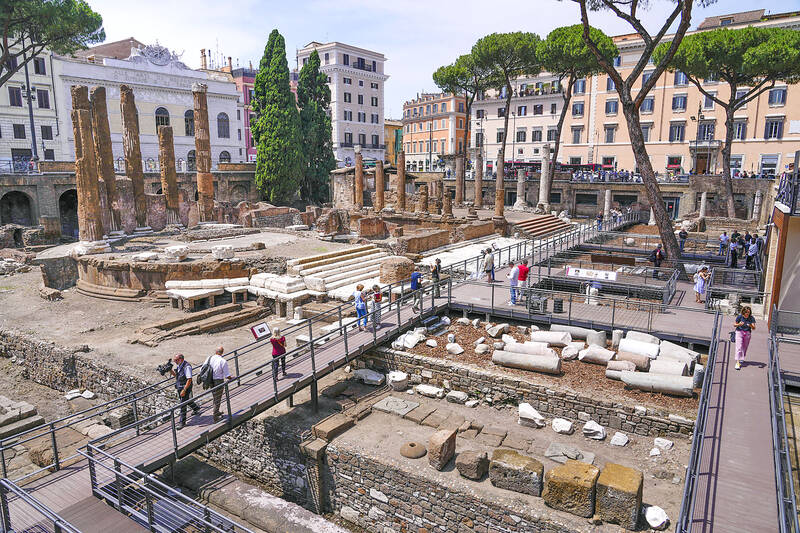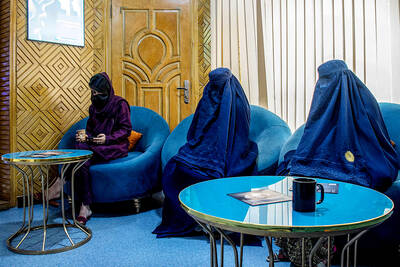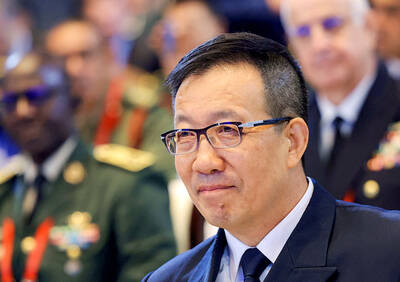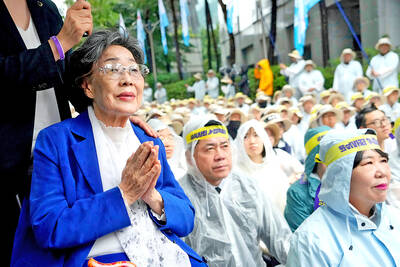Four temples from ancient Rome, dating back as far as the 3rd century BC, stand smack in the middle of one of the modern city’s busiest crossroads, but until Monday, practically the only ones getting a close-up view of the temples were the cats that prowl the so-called “Sacred Area,” on the edge of the site where Julius Caesar was assassinated.
With the help of funding from Bulgari, the luxury jeweler, the grouping of temples can now be visited by the public.
For decades, the curious had to gaze down from the bustling sidewalks rimming Largo Argentina (Argentina Square) to admire the temples below. That is because, over the centuries, the city had been built up, layer by layer, to levels several meters above the area where Caesar masterminded his political strategies and was later fatally stabbed in 44 BC.

Photo: AP
Behind two of the temples is a foundation and part of a wall that archeologists believe were part of Pompey’s Curia, a large rectangular-shaped hall that temporarily hosted the Roman Senate when Caesar was murdered.
What leads archeologists to pinpoint the ruins as Pompey’s Curia?
“We know it with certainty because latrines were found on the sides” of Pompey’s Curia and ancient texts mentioned the latrines, said Claudio Parisi Presicce, an archeologist and Rome’s top official for cultural heritage.
The temples emerged during the demolition of medieval-era buildings in the late 1920s, part of Italian dictator Benito Mussolini’s campaign to remake the urban landscape. A tower at one edge of Largo Argentina once topped a medieval palace.
The temples are designated A, B, C and D, and are believed to have been dedicated to female deities.
One of the temples, reached by an imposing staircase and featuring a circular form and with six surviving columns, is believed to have been erected in honor of Fortuna, a goddess of chance associated with fertility.
Taken together, the temples make for “one of the best-preserved remains of the Roman Republic,” Parisi Presicce said after Rome Mayor Roberto Gualtieri cut a ceremonial ribbon on Monday afternoon.
On display in a corridor near the temples is a black-and-white photograph showing Mussolini cutting the ribbon in 1929 after the excavated ruins were shown off.
Also visible are the travertine paving stones that Emperor Domitian had laid down after a fire in 80 AD ravaged a large swath of Rome, including the Sacred Area.
On display are some of the artifacts found during last century’s excavation. Among them is a colossal stone head of one of the deities honored in the temples, chinless and without its lower lip. Another is a stone fragment of a winged angel of victory.
Over the past decades, a cat colony flourished among the ruins. Felines lounged undisturbed and cat lovers were allowed to feed them.
One black-and-white cat on Monday sprawled lazily on its back atop the stone stump of what was once a glorious column.
Bulgari helped pay for the construction of the walkways and nighttime illumination. A relief to tourists who step gingerly over the uneven ancient paving stones of the Roman Forum.
The Sacred Area’s wooden walkways are wheelchair and baby-stroller-friendly. For those who cannot handle the stairs down from the sidewalk, an elevator platform is available.
The attraction is open every day except for Mondays and some major holidays, with general admission tickets priced at 5 euros (US$5.50).
Curiously, the square owes its name not to the South American nation, but to the Latin name of Strasbourg, France, which was the home seat of a 15th-century German cardinal who lived nearby and who served as master of ceremonies for pontiffs, including Alexander VI, the Borgia pope.

Decked out with fake crystal chandeliers and velvet sofas, cosmetic surgery clinics in Afghanistan’s capital are a world away from the austerity of Taliban rule, where Botox, lip filler and hair transplants reign. Despite the Taliban authorities’ strict theocratic rule, and prevailing conservatism and poverty in Afghanistan, the 20 or so clinics in Kabul have flourished since the end of decades of war in the country. Foreign doctors, especially from Turkey, travel to Kabul to train Afghans, who equally undertake internships in Istanbul, while equipment is imported from Asia or Europe. In the waiting rooms, the clientele is often well-off and includes men

BEIJING FORUM: ‘So-called freedom of navigation advocated by certain countries outside the region challenges the norms of international relations,’ the minister said Chinese Minister of National Defense Dong Jun (董軍) yesterday denounced “hegemonic logic and acts of bullying” during remarks at a Beijing forum that were full of thinly veiled references to the US. Organizers said that about 1,800 representatives from 100 countries, including political, military and academic leaders, were in Beijing for the Xiangshan Forum. The three-day event comes as China presents itself as a mediator of fraught global issues including the wars in Ukraine and Gaza. Addressing attendees at the opening ceremony, Dong warned of “new threats and challenges” now facing world peace. “While the themes of the times — peace and development —

COMFORT WOMEN CLASH: Japan has strongly rejected South Korean court rulings ordering the government to provide reparations to Korean victims of sexual slavery The Japanese government yesterday defended its stance on wartime sexual slavery and described South Korean court rulings ordering Japanese compensation as violations of international law, after UN investigators criticized Tokyo for failing to ensure truth-finding and reparations for the victims. In its own response to UN human rights rapporteurs, South Korea called on Japan to “squarely face up to our painful history” and cited how Tokyo’s refusal to comply with court orders have denied the victims payment. The statements underscored how the two Asian US allies still hold key differences on the issue, even as they pause their on-and-off disputes over historical

BRIBERY ALLEGATIONS: A prosecutor said they considered the risk of Hak-ja Han tampering with evidence to be very high, which led them to seek the warrant South Korean prosecutors yesterday requested an arrest warrant for the leader of the Unification Church, Hak-ja Han, on allegations of bribery linked to the country’s former first lady and incitement to destroy evidence. The move came a day after the 82-year-old was questioned over her alleged role in bribing former first lady Kim Keon-hee and a lawmaker. Founded in 1954 by her late husband, Sun Myung Moon, the Unification Church has long been the subject of controversy and criticism, with its teachings centered on Moon’s role as the “second coming” and its mass weddings. Followers are derisively referred to as “Moonies.” However, the church’s